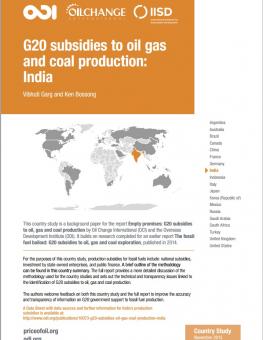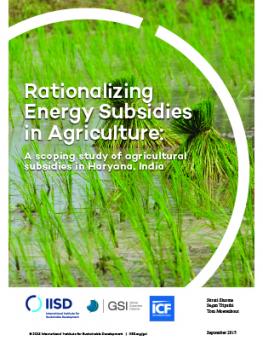Kerosene is used by millions of households in rural India to meet basic lighting needs, and subsidies have long been used to make the fuel more affordable. But for health, safety and environmental reasons, a switch to solar power is better—and more affordable in the absence of kerosene subsidies.
Subsidies for kerosene have been at the centre of energy policy debates for many years due to the intrinsic problems with kerosene consumption and the inefficiencies in subsidized kerosene distribution. The poor quality light produced from kerosene lamps limits educational and income-generating opportunities, while the fuel is also responsible for serious negative health impacts. Moreover, the provision of subsidized kerosene is extremely costly and wasteful. The Indian Government’s Economic Survey estimates that 41 per cent of subsidized kerosene was lost due to "leakages" in the system in 2011–12 (see page 54 of the survey).
In order to curb the black market in subsidized kerosene, the Indian Government has proposed changing kerosene subsidy delivery from in-kind subsidies (i.e., sale of low-cost fuel) to cash transfers to consumers following the purchase of kerosene. This would allow the government to better control access the subsidy.
However, the Government of India should reconsider subsidies for kerosene more fundamentally. Our analysis shows that kerosene subsidies are holding back a transition to solar power.
Replacing kerosene with solar power
Off-grid solar technologies, such as solar lanterns and solar home systems can effectively replace kerosene use for lighting in rural areas that are unserved (or poorly served) by the electricity grid and are likely to be so for some time. Solar can provide safer and better quality lighting, and is also friendly to the environment.
Kerosene subsidies, however, reduce the competitiveness of off-grid solar solutions. To understand the extent to which kerosene subsidies are discouraging poor, rural households from making the switch to solar power, IISD examined the different cost scenarios that households face when making the choice between kerosene and solar lantern use.
The economics of kerosene and small solar lighting options
To make this assessment, the costs of three solar lantern types (entry-level, mid-level and high-level) were assessed. Further, in addition to upfront purchase, a simple financing option for the various solar lanterns was considered.
Detailed cost calculations reveal that—at the current level of kerosene subsidies—household expenditure on entry-level solar lighting systems is marginally lower than that on kerosene. If kerosene subsidies are removed, however, and households shifted from kerosene to entry-level solar products they will save INR 760 over 1.5 years (approximately USD 12), equal to 150 per cent of the capital cost of an entry-level lantern. For both mid-level and high-level solar lantern systems, expenditure is greater than on kerosene over the two-year life of the systems in the case where kerosene subsidies are maintained. However, where kerosene subsidies are removed, households with mid-level systems make significant savings by switching to solar over two years.
Given current kerosene subsidy levels, households using more expensive high-level systems incur additional expenditure of INR 1248 (USD 20) over two years when systems are paid for upfront. However, even for high-level systems—which also include mobile phone charging capacity—households save from shifting to solar when kerosene subsidies are zero and systems are paid for upfront.
Policies to move from kerosene to solar
The implication of this analysis is clear. A range of solar lantern products are more cost effective than kerosene over their lifetime when kerosene subsidies are removed. Where subsidies are left in place, the savings are relatively small for some systems and non-existent for others. To stimulate a large-scale transition toward solar lighting in rural India, kerosene subsidy reform is therefore crucial. There is much that governments at the central and state levels can do to promote this process of reform.
For example, the Indian Government can:
- Tighten the eligibility criteria of kerosene subsidies across states to restrict kerosene subsidy access to households below the poverty line, while strictly tying eligibility to a lack of electricity access in places where kerosene is mainly used for lighting.
- Establish funded retraining programs for kerosene dealers now, and allow fair price (i.e., ration) shops to sell accredited solar lighting alternatives in order to reduce political opposition to the process of reform.
- Begin testing an ambitious restructuring of the current kerosene subsidy to transform this into a general "lighting subsidy," under which direct subsidy benefits can be used by beneficiaries towards the purchase of a range lighting products, including kerosene and solar solutions.
Nevertheless, kerosene subsidy reform is an intrinsically difficult process. In the absence of affordable and widely available lighting alternatives, rapid kerosene subsidy reform risks depriving the poorest households in India of an important social benefit.
Indeed, while using a range of solar lanterns is often cheaper than kerosene use (when unsubsidized) over the full lifetime of the product, poor households often struggle to afford the one-off upfront cost of small solar appliances—the consumption of which is not spread over time as it is with kerosene. As such, in tandem with kerosene subsidy reform, government policy should focus on tackling the barriers to greater off-grid solar penetration, and in particular the financial and upfront cost barriers that exist, including through measures that allow for and encourage innovative payment options for solar solutions over time. This will in turn allow for more determined reform of kerosene subsidies. How exactly to encourage greater solar penetration in rural areas is the subject of second blog in this series.
For a copy of the calculations referenced above, contact the author Vibhuti Garg at vibhuti.garg@iisd.org.







